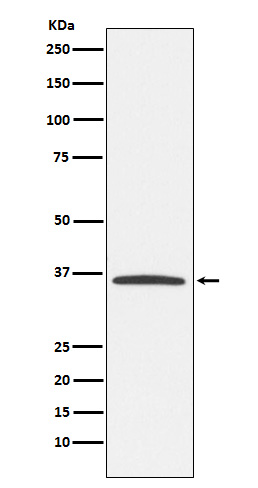
| WB | 咨询技术 | Human,Mouse,Rat |
| IF | 咨询技术 | Human,Mouse,Rat |
| IHC | 咨询技术 | Human,Mouse,Rat |
| ICC | 1/50-1/200 | Human,Mouse,Rat |
| FCM | 1/20-1/100 | Human,Mouse,Rat |
| Elisa | 咨询技术 | Human,Mouse,Rat |
| Aliases | E2F 6; E2F-6; E2F6; EMA;;E2F6 |
| WB Predicted band size | 32 kDa |
| Host/Isotype | Rabbit IgG |
| Antibody Type | Primary antibody |
| Storage | Store at 4°C short term. Aliquot and store at -20°C long term. Avoid freeze/thaw cycles. |
| Species Reactivity | Human |
| Immunogen | A synthesized peptide derived from human E2F6 |
| Formulation | Purified antibody in PBS with 0.05% sodium azide,0.05% BSA and 50% glycerol. |
+ +
以下是3篇与E2F6抗体相关的参考文献概述:
1. **文献名称**: "E2F6 regulates apoptosis through transcriptional control of Bim"
**作者**: Chong et al. (2018)
**摘要**: 该研究利用E2F6特异性抗体进行染色质免疫沉淀(ChIP)分析,揭示E2F6通过直接结合Bim基因启动子抑制其转录,从而调控细胞凋亡途径。
2. **文献名称**: "Characterization of a novel monoclonal antibody against human E2F6 for cancer biomarker studies"
**作者**: Tanaka et al. (2020)
**摘要**: 研究团队开发了一种高特异性的抗人E2F6单克隆抗体,验证其在免疫印迹(Western Blot)和免疫组化(IHC)中的有效性,并发现E2F6在多种实体瘤中异常高表达。
3. **文献名称**: "E2F6 interacts with polycomb repressive complexes to silence developmental genes"
**作者**: Novais-Cruz et al. (2016)
**摘要**: 使用E2F6抗体进行免疫共沉淀(Co-IP)实验,证明E2F6与PRC1/PRC2复合物物理结合,协同抑制胚胎干细胞中发育相关基因的表达。
The E2F6 antibody is a crucial tool in studying the E2F transcription factor family, which regulates cell cycle progression, apoptosis, and differentiation. E2F6. a member of the E2F family, functions primarily as a transcriptional repressor. Unlike other E2F proteins (E2F1-E2F5), E2F6 lacks binding domains for tumor suppressor proteins like pRB but recruits polycomb repressive complexes to silence target genes, particularly during the G1/S phase transition. It plays roles in cell cycle arrest, embryonic development, and maintaining stem cell pluripotency. Dysregulation of E2F6 is linked to cancers, where its overexpression may promote uncontrolled proliferation.
E2F6 antibodies are designed to detect and quantify endogenous E2F6 protein levels in various applications, including Western blotting, immunohistochemistry, and chromatin immunoprecipitation (ChIP). These antibodies help researchers explore E2F6’s interaction with partners like EAP1 or polycomb group proteins, its regulatory mechanisms, and its role in diseases. Specificity validation (via knockout controls) is essential due to structural similarities among E2F family members. As a repressive E2F, studying E2F6 provides insights into cell cycle checkpoints and potential therapeutic targets in oncology. Its antibody remains vital for dissecting transcriptional networks in normal and pathological states.
×